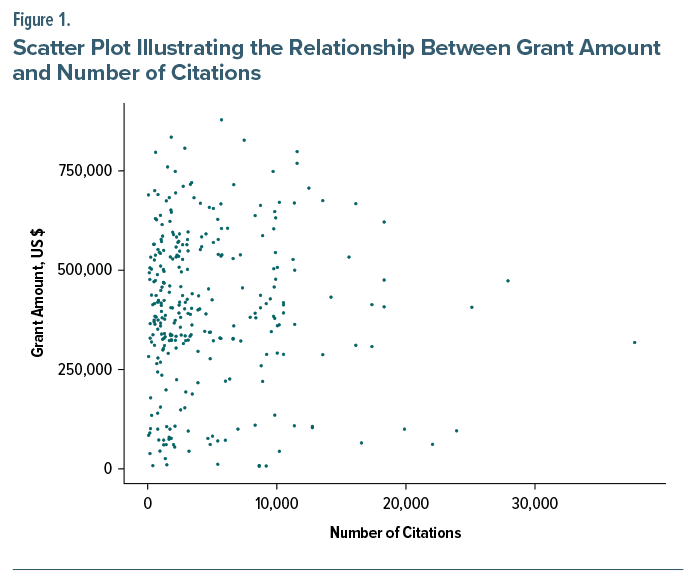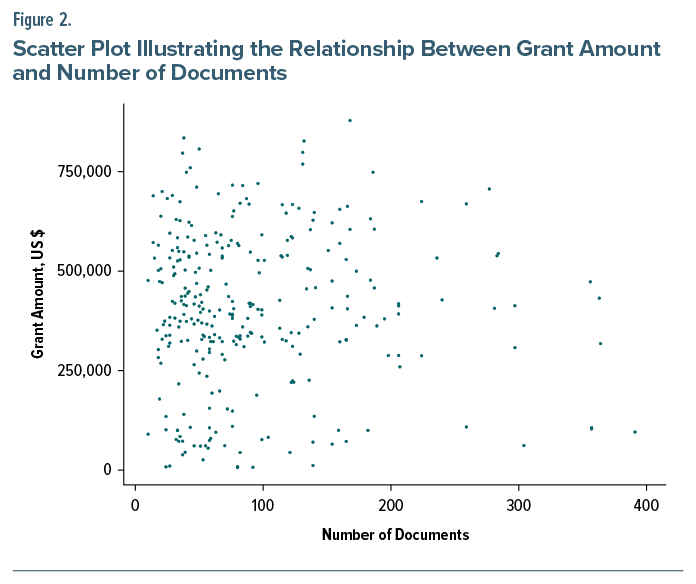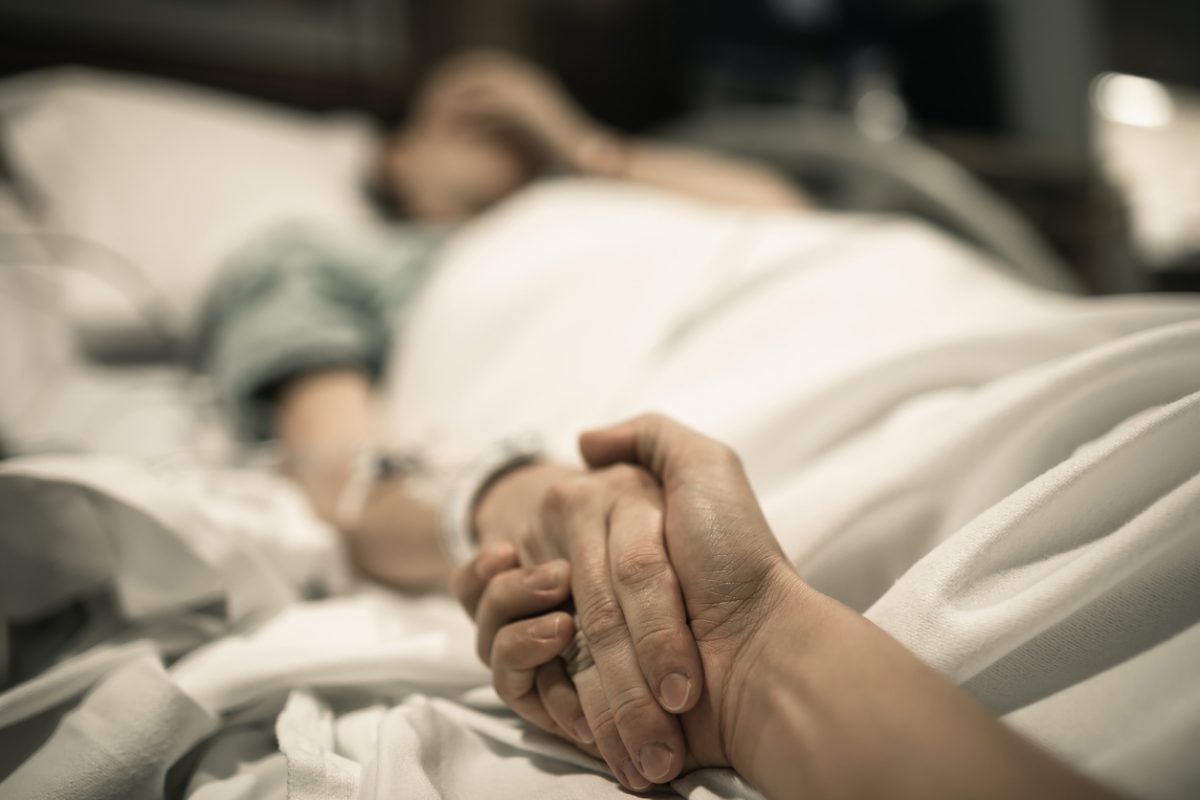Women have historically been underrepresented in leadership roles and are less likely than men to be awarded grants in academic medicine.1 Despite significant recent improvements in psychiatry research, trends in financing for this field of study are still being determined. As a result, we examined National Institutes of Health (NIH) funding patterns in the distribution of R01 grants for gender specific psychiatry research.
Methods
To gather data on funding amount, principal investigator (PI), co-PIs, and institution name for R01 grants in psychiatry research from 2013 to 2020, a search was conducted in the NIH RePORTER (Research Portfolio Online Reporting Tools Expenditures and Results) using psychiatry-related search and Medical Subject Heading terms. The gender of each PI was classified utilizing the Genderize tool. In cases wherein the likelihood threshold for gender assignment fell below 95%, personal pronouns were employed on institutional profiles. The Consumer Price Index was used as a means to alter the grant amount to reflect its equivalent value in US dollars for the year 2020. The data pertaining to number of citations, publications, H-index, and seniority were extracted from Scopus and Web of Science databases in January 2023. The concept of seniority was operationalized as the duration in years between the initial publication and the moment of receiving the grant award. A linear regression analysis was used to examine patterns in funding. The study employed multiple linear regression analysis to examine the association between funding amount and gender, while controlling for covariates such as number of publications, citations, degrees, institution, H-index, and seniority. A significance level of <.05 was used to determine statistical significance.
Results
A total of $3.7 billion was awarded to the PIs in psychiatry. A total of 7,192 grants was given over the 8-year period. Women only received 2,881 of these grants (ie, only 40%). From 2013 to 2020, the number of grants awarded increased significantly among both men and women. The percentage of grants given to women rose from a mere 304 out of a total of 876 grants (34%) in 2013 to 460 out of a total of 990 grants (46%) in 2020. This indicates a trend in a positive direction.
Similarly, the amount of grants also increased for both genders from 2013 to 2020. For instance, the average grant given to women in 2013 was $411,811, which increased to $592,577 in 2020. Further, the total amount of grants given also showed a similar increase; for example, the cumulative grant given to women in 2013 was $125 million, which rose to $273 million in 2020. The rate of change in total grant dollars and total number of grants per person was higher in women compared with men.
Coefficients. The estimated coefficients for each predictor variable in the model represent the change in the dependent variable (grant amount) for a 1-unit change in each predictor variable while holding other variables constant.
- Intercept: The estimated value of the dependent variable when all predictor variables are zero. In this case, it is estimated to be approximately $528,800.
- Gender: The estimated change in the dependent variable for a change of 1 unit in the “gender” variable. However, with a high P value of .493, the gender variable is not statistically significant in predicting the grant amount.
Data Collection. We collected a dataset containing information about grant recipients, including their gender, citations, documents, and the amount of grant given.
Data Preparation. After importing the dataset into R, we conducted data cleaning and preprocessing to ensure accurate and consistent results. We verified column names, removed missing values, and organized the data.
Multiple Linear Regression. To investigate the relationships between grant amount and predictor variables, we utilized the lm() function to fit a multiple linear regression model. The model included gender, citations, and documents as predictor variables, while the grant amount served as the dependent variable.
Model Assessment. We examined the coefficients, standard errors, t values, and P values provided by the model summary to assess the statistical significance of each predictor variable. We also evaluated the R-squared value to determine how well the model explained the variance in grant amounts.
Visualization. We employed the ggplot2 package to create scatter plots illustrating the relationships between nonsignificant predictor variables (gender, citations, and documents) and the grant amount (Figures 1 and 2). Each plot depicted the predictor on the x-axis and the grant amount on the y-axis.
Potential variables that could contribute to this issue may encompass a lower representation of female psychiatrists, a smaller pool of female applicants, or potential biases in the evaluation process during grant application reviews. Factors that are situated upstream, such as insufficient institutional support, limited access to mentorship, and inequitable work environments, may potentially place women applicants at a disadvantage.1 The research findings indicate that there is a tendency for women’s scholarly work to have fewer citations, resulting in a lower H-index.2 The findings of our analysis indicate a positive correlation between the number of publications and H-index and the amount of grant funding received.
This finding suggests that the inclusion of high-impact articles may be a significant factor in the evaluation of grant applications. Hence, it is imperative to incorporate women into research and authorship networks as part of a holistic strategy to promote and support female investigators, while also addressing the discrepancies that exist in NIH-funded psychiatry research.
Discussion
It is important to acknowledge the limitations of this study. Initially, it is important to note that the information provided by NIH RePORTER solely pertains to grants that have received funding. Consequently, it does not encompass the total number of grant applications or success rates associated with these applications. Also, it is possible that the search phrases related to psychiatry did not capture all of the available grants. Furthermore, the measurement of seniority was based on the number of years after the initial publication rather than the individual’s academic rank. While the findings of this analysis indicate a slight advancement in achieving gender equality in R01 awards, it is imperative to emphasize the need for deliberate actions to address the persistent gender disparity.
Article Information
Published Online: September 19, 2024. https://doi.org/10.4088/PCC.24br03725
© 2024 Physicians Postgraduate Press, Inc.
Prim Care Companion CNS Disord 2024;26(5):24br03725
Submitted: February 17, 2024; accepted May 13, 2024.
To Cite: Ali M, Ahmed A, Talha M, et al. Trends in National Institutes of Health RO1 funding of principal investigators in psychiatry by gender. Prim Care Companion CNS Disord. 2024;26(5):24br03725.
Author Affiliations: Department of Psychiatry, King Edward Medical University, Lahore, Pakistan (Ali, Ahmed, Afzal, Tahir); CMH Lahore Medical College, Lahore, Pakistan (Talha); Valley Health System/Universal Health Services, Las Vegas, Nevada (Shad); Touro University of Nevada College of Osteopathic Medicine, Las Vegas, Nevada (Shad); University of Nevada, Las Vegas, Nevada (Shad).
Corresponding Author: Mohsan Ali, MBBS, Department of Psychiatry, King Edward Medical University, Neela Gumbad Chowk, Lahore 54000, Pakistan ([email protected]).
Relevant Financial Relationships: None.
Funding/Support: None.
References (2)

- Carnes M, Morrissey C, Geller SE. Women’s health and women’s leadership in academic medicine: hitting the same glass ceiling? J Womens Health (Larchmt). 2008; 17(9):1453–1462. PubMed CrossRef
- Ha GL, Lehrer EJ, Wang M, et al. Sex differences in academic productivity across academic ranks and specialties in academic medicine: a systematic review and meta-analysis. JAMA Netw Open. 2021;4(6):e2112404. PubMed CrossRef
Please sign in or purchase this PDF for $40.







